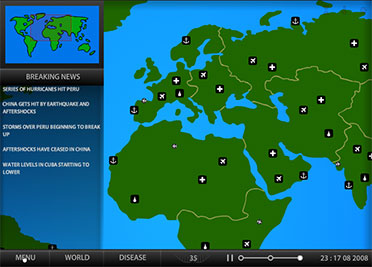Pandemic II

Pandemic II is a free to play browser game by Dan Archibald of Dark Realm Studios.
What does it teach?
It is first and foremost a pure strategy game about global disease transmission. It wasn’t designed with any educational intentions, so any lessons learned about epidemiology and medical microbiology are just bonus spillovers.
What do you do?
You create a pathogen (bacteria, virus or parasite) that you try to spread from country to country to ultimately kill every human being on earth before the planet’s scientists can come up with a vaccine.
To accomplish your mission you are able to change your pathogens properties that affect the three principal parameters under your direct control:
- Lethality
- Infectivity
- Visibility
For example choosing vomiting as a symptom will increase lethality slightly by dehydrating hosts; it will increase infectivity significantly by exposing others to pathogen-rich body fluids and, finally, it will also increase visibility a lot as vomiting is a very noticeable symptom. Fevers, on the other hand, have the advantage of being deadly while barely being noticeable.
Your best strategy depends on which country you start in, but you should always try to keep the lethality and visibility low in the beginning. Otherwise other countries will shut down their borders by closing airports and seaports. It is better to infect every country without causing any deaths or conspicuous symptoms and then equip your pathogen with lethal symptoms to kill off all infected people (this is, to put it mildly, hefty artistic license as all of the pathogens of the infected individuals could never evolve a new virulence factor at the same time).
You also have to take account of the geography, climate and the natural disasters occurring randomly in different countries. If, for example, there is a flood in an area that you are already infecting you should choose “waterborne” as your pathogen’s route of transmission. This will make it spread much quicker throughout that region. And if you want to spread the disease from Russia to the Middle East, you should make your pathogen resistant to heat and perhaps pick insects or rodents for vector-borne transmission.
Do you learn anything?
An average player will very likely increase his awareness of how diseases spread and gain a better understanding of what role transportation and virulence factors play in that process. He might also gain new appreciation for the ways society deals with epidemics: closing borders, airports and schools; exterminating rodents, imposing curfews and martial law; hurrying to develop vaccines that may or may not work, etc. The player might pick up same basic geography too!
Pandemic II is in fact a very good example of an educational simulation, which I wrote about in my review of Conflict: Immunity. Simulation games are uniquely able to make the workings of systems clear and comprehensible. Epidemiology is all about systems; it is all about lots of interconnecting objects and processes and thus in some respects better explained by a game than by a textbook or a lecture.
You will certainly kill more people and increase your score the better you understand the principles of epidemiology as they are modelled in the game. This doesn’t necessarily mean that you will gain greater understanding of real-life epidemiology as the simulation model is vastly simplified and perhaps even fundamentally wrong. True, textbook models might also be wrong, but the risk with games is the incentive to exploit the model: to search for weak spots in the algorithms in order to increase your score, rather than to focus on the sound foundations of the algorithms in order to increase your understanding.
Pros
Pandemic II is unusually ambitious for a free flash game from a small developer. The complex interplay between geography, communications and pathogen attributes makes for deep gameplay with lots of replay value and actual educational benefits.
Cons
If you don’t like strategy games or board games of the Risk variety, chances are it will bore you.
Additional information
Dan Archibald originally made the turn based Pandemic in 2007. It was quickly followed by Pandemic: Extinction of Man (2007) and then Pandemic II (2008), which was big hit in the flash game market and spawned the President Madagascar-meme. It was a major improvement on the first two games and served as a template for later infect-the-world games.
The first one of those was Archibald’s own Pandemic 2.5 (2012). for iOS It was a relatively successful but eclipsed by the release of James Vaughan’s Plague Inc. for iOS and Android just three weeks later. While it was clearly a blatant clone of Archibald’s 2008 opus, it was also generally deemed more of an improvement than Archibald’s own 2012 effort and outsold it by a factor of two. More recently Vaughan has taken the genre even further with Plague Inc: Evolved (2014) for PC and Mac (Xbox One forthcoming) while cash-in clones like Infection Bio War (2014) has arrived on iOS and Android.
There have also been topical spin-offs like Archibald’s Pandemic: American Swine (2009): a role reversal where you fight the 2009 swine flu pandemic in the United States. Killer Flu (2009) by Ian Bogost and The Great Flu (2009) by Erasmus Medical Centre in Rotterdam are two similar and institutionally sponsored browser-based games.
Ola Hansson, 22 October 2014

